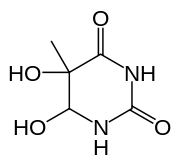Thymine glycol
Thymine glycol (5,6-dihydroxy-5,6-dihydrothymine) is one of the principal DNA lesions that can be induced by oxidation and ionizing radiation.[1]
 | |
| Names | |
|---|---|
| IUPAC name
5,6-Dihydroxy-5-methyldihydro-2,4(1H,3H)-pyrimidinedione | |
| Other names
5,6-Dihydroxy-5,6-dihydrothymine | |
| Identifiers | |
3D model (JSmol) |
|
| ChemSpider | |
| |
| Properties | |
| C5H8N2O4 | |
| Molar mass | 160.129 g·mol−1 |
Except where otherwise noted, data are given for materials in their standard state (at 25 °C [77 °F], 100 kPa). | |
| Infobox references | |
Aging, stroke
The rate at which oxidative reactions generate thymine glycol and thymidine glycol in the DNA of humans is estimated to be about 300 per cell per day.[2] Oxidized DNA bases that are excised by DNA repair processes are excreted in urine. On a body weight basis, mice excrete 18 times more thymine glycol plus thymidine glycol than humans, and monkeys four times more than humans.[2] It was proposed that rate of occurrence of oxidative DNA damages correlates with metabolic rate, and that a higher rate of oxidative damage might cause a higher rate of cellular aging.[2]
Base excision repair is a major DNA repair pathway for removal of oxidative DNA damages. The rate of repair of thymine glycol damage in human fibroblasts was found to decrease with age.[3] Brain samples from humans who died of stroke were found to be deficient in base excision repair of thymine glycol as well as other types of oxidative damages.[4] It was suggested that impaired base excision repair is a risk factor for ischemic brain injury.[4]
References
- Basu, AK; Loechler, EL; Leadon, SA; Essigmann, JM (1989). "Genetic effects of thymine glycol: site-specific mutagenesis and molecular modeling studies". Proc. Natl. Acad. Sci. U.S.A. 86: 7677–81. doi:10.1073/pnas.86.20.7677. PMC 298133. PMID 2682618.
- Adelman R, Saul RL, Ames BN (1988). "Oxidative damage to DNA: relation to species metabolic rate and life span". Proc. Natl. Acad. Sci. U.S.A. 85 (8): 2706–8. doi:10.1073/pnas.85.8.2706. PMC 280067. PMID 3128794.
- Pons B, Belmont AS, Masson-Genteuil G, Chapuis V, Oddos T, Sauvaigo S (2010). "Age-associated modifications of Base Excision Repair activities in human skin fibroblast extracts". Mech. Ageing Dev. 131 (11–12): 661–5. doi:10.1016/j.mad.2010.09.002. PMID 20854835.
- Ghosh S, Canugovi C, Yoon JS, Wilson DM, Croteau DL, Mattson MP, Bohr VA (2015). "Partial loss of the DNA repair scaffolding protein, Xrcc1, results in increased brain damage and reduced recovery from ischemic stroke in mice". Neurobiol. Aging. 36 (7): 2319–30. doi:10.1016/j.neurobiolaging.2015.04.004. PMC 5576895. PMID 25971543.